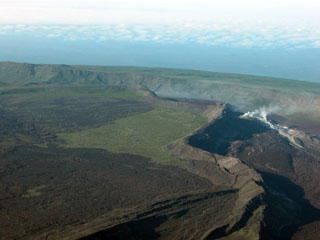Report on Sierra Negra (Ecuador) — 27 June-3 July 2018
Smithsonian Institution / US Geological Survey
Weekly Volcanic Activity Report, 27 June-3 July 2018
Managing Editor: Sally Sennert.
Please cite this report as:
Global Volcanism Program, 2018. Report on Sierra Negra (Ecuador) (Sennert, S, ed.). Weekly Volcanic Activity Report, 27 June-3 July 2018. Smithsonian Institution and US Geological Survey.
Sierra Negra
Ecuador
0.83°S, 91.17°W; summit elev. 1124 m
All times are local (unless otherwise noted)
Based on video and photos shared by Parque Nacional Galápagos staff, IG reported that the eruption at Sierra Negra that began at 1340 on 26 June originated from several fissures on the N flank and one within the caldera. The flank flows reached the sea between Elizabeth Bay and Punta Morena. A gas-and-ash plume rose about 10.5 km and drifted W. Seismic and acoustic data indicated a gradual decrease but continuing activity on 27 June. A small seismic event was recorded at 1552 on 1 July, followed by at least four hours of tremor. At 1600 national park staff observed lava flows on the NW flank.
Geological Summary. The broad shield volcano of Sierra Negra at the southern end of Isabela Island contains a shallow 7 x 10.5 km caldera that is the largest in the Galápagos Islands. Flank vents abound, including cinder cones and spatter cones concentrated along an ENE-trending rift system and tuff cones along the coast and forming offshore islands. Although it is the largest of the five major Isabela volcanoes, it has the flattest slopes, averaging less than 5° and diminishing to 2° near the coast. A sinuous 14-km-long, N-S-trending ridge occupies the west part of the caldera floor, which lies only about 100 m below its rim. The Volcán de Azufre fumarolic area lies within a graben between this ridge and the west caldera wall. Lava flows from a major eruption in 1979 extend all the way to the north coast from circumferential fissure vents on the upper northern flank.
Source: Instituto Geofísico-Escuela Politécnica Nacional (IG-EPN)

